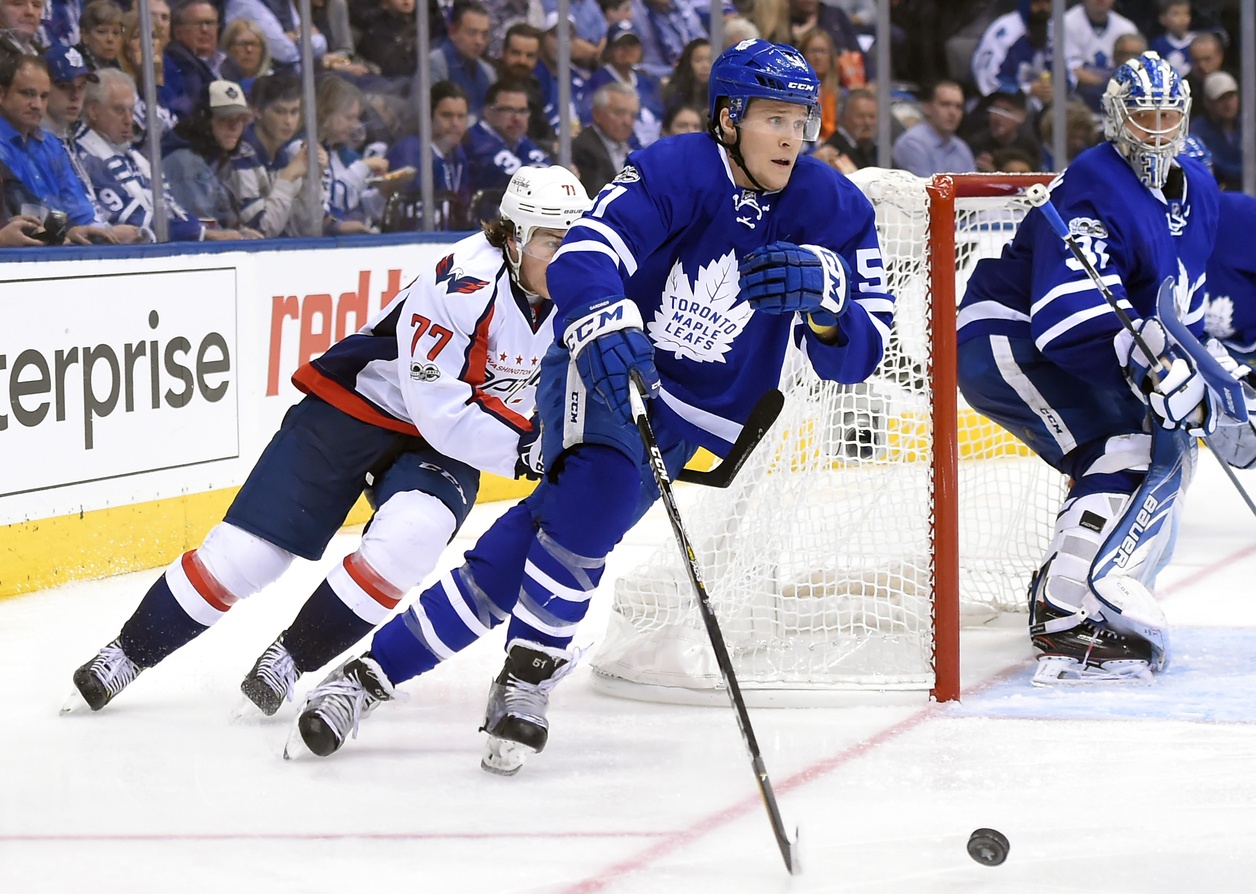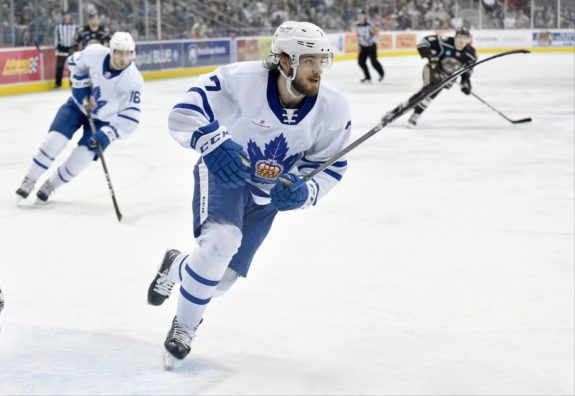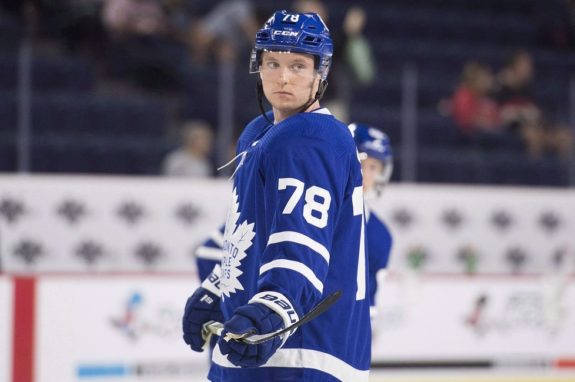Since joining the team in 2011, Jake Gardiner has been the most polarizing player on the Toronto Maple Leafs. His skill and swashbuckling style of play left fans amazed at some times and frustrated at others. It was not uncommon to see the smooth-skating defenceman make a costly giveaway in his own end, only to follow it up with an elusive move to create a scoring chance on the very next shift.

And now that the Leafs’ season has come to an end, so has Gardiner’s tenure with the team. The 28-year old defenceman will become an unrestricted free agent (UFA) on July 1, and given the Leafs’ tight salary cap, there is virtually no chance of re-signing him. As a mobile, puck-moving defenceman, Gardiner will have no shortage of suitors. Coming off a five-year deal that paid him just $4.05 million per season, he will be looking for a hefty raise, and rightfully so.
Whether in the form of Twitter comments, boos from the home crowd, or animated arguments at the bar, Gardiner was the whipping boy for the media and fanbase over the past few seasons.
But what most hockey fans in Toronto don’t realize is just how good Gardiner has been for the Leafs, and how much his absence will be felt next season.
A Top-Pairing Defenceman
Whether you’re a Gardiner supporter or not, it’s impossible to deny how crucial the Minnesota native has been for the Leafs since becoming a full-time NHLer in the 2011-12 season.
Gardiner is currently the second-longest serving Leaf behind only Nazem Kadri. Over the past eight seasons, Gardiner has played in 551 regular season games, plus 26 playoff games. He is the 11th-most tenured Leafs defenceman of all-time.

Over the last three seasons, Gardiner has averaged 21:48 of ice time per game, 53rd amongst NHL defencemen over that span. Even more impressively, he ranks 23rd in points amongst defencemen with 125, and 25th in points-per-60 minutes (1.52) over that same time frame. This rate of production tops stars around the league such as Alex Pietrangelo, Zach Werenski, Shea Weber, Drew Doughty, and many others.
Comparing Gardiner to his teammates only further highlights his importance. Since 2016-17, his production from the blue line is bested only by Morgan Rielly’s 152 points. Third-ranked Nikita Zaitsev is all the way down at 63, illustrating just how much of the load Rielly and Gardiner have carried.
The usually durable defender missed over a month of action when he was taken out of the lineup with a back injury on Feb. 27. The Leafs felt his absence immediately, sputtering along at 8-7-3 until his return on April 4.
Despite all of the complaints about Gardiner’s play – that he’s too soft, too nonchalant, or too inconsistent – the numbers speak for themselves. On top of that, general manager Kyle Dubas has spoken publicly about his importance and clearly understands Gardiner’s value in the modern game.

“The one thing I would reiterate is how important he’s been to turning the organization around,” Dubas said of Gardiner in a January press conference. “Jake is a player that has the puck a lot. When you play hockey and you have the puck a lot, and you try to be creative and you make skilled plays, from time to time, they’re not going to go your way.
“With Jake, the positive far, far outweighs the times when it doesn’t go right. That’s why we like him and that’s why he’s been so important for us over the last number of years or since we’ve been here,” said Dubas.
An Analytics Darling
Gardiner is a bona fide top-pairing defenceman by almost any measure, and that’s especially clear once you dive into stats beyond the box scores. He’s been known as a bit of an analytics darling during his entire career by those who are statistically inclined, and his 2018-19 season was no exception.

According to goals above replacement (GAR), an all-encompassing stat to evaluate skaters, Gardiner ranked 17th among defencemen in 2018-19. If we look at only even-strength impact, Gardiner ranked fifth.
Yes, with all the turnovers, blunders, bobbles, and miscues, Gardiner was still the fifth-best defenceman at even-strength last season. He does so many subtle yet effective things that tilt the ice in his team’s favour, which is why he’s a legitimate top-30 defender in the league. Like the Leafs’ general manager said: with high-skill players like Gardiner, you take the bad with the good, because the good heavily outweighs the bad.
This RAPM chart compares Gardiner and Rielly at even-strength over the past three seasons (2016-2019). There is a clear difference between the two players: Rielly is elite offensively but weak defensively, while Gardiner has positive impacts on both sides of the ice – especially on offence. For how good Rielly is in the offensive zone, he gives quite a bit back in his own end in both shots (Def_CF) and expected goals against (Def_xG). Meanwhile, Gardiner is a fantastic two-way defender who does everything well.

This chart uses “microstats” which involve manual tracking. It’s particularly valuable for player evaluation because it quantifies the subtle plays that viewers often miss. It breaks down contributions into four distinct categories: shot contributions, zone entries (at the offensive blue line), zone exits (at the defensive blue line), and entry defence (defending own blue line).
Once again, Rielly excels at offensive contributions and transitional play, but he’s poor when it comes to stifling the opposition at his own blue line. Gardiner is well above average at everything including defending his own blue line, which he normally often doesn’t get enough credit for.
All of this is not to take anything away from Rielly, who is an absolute stud. The point is to make you rethink how you evaluate players and in turn, reconsider who has really been the Leafs’ best defenceman over the past several seasons. It’s easy to focus on a costly turnover, but what a lot of viewers overlook are the dozens of subtle plays Gardiner makes – with and without the puck – to help his team win on any given night.
The Leafs’ Defence and Potential Replacements
With Gardiner’s imminent exit, the Leafs’ already questionable defence looks even worse. Igor Ozhiganov is going back to the KHL and unrestricted free agent Ron Hainsey won’t be re-signed if Dubas has his way. That leaves head coach Mike Babcock with Rielly, Zaitsev, Jake Muzzin, and Travis Dermott as his likely top-four.
Travis Dermott
Dermott seems like Toronto’s best bet to fill the void left by Gardiner’s absence. The 22-year old finished his first full NHL season with 17 points in 64 games played, mostly utilized in a sheltered third-pairing role. The Newmarket, Ontario native was generally impressive, with some occasional youthful mistakes. The important thing is that he’s demonstrated the tools – skating, passing, physicality, and hockey IQ – to be at least a top-four NHL defenceman. Whether he can take that next step sooner rather than later has yet to be seen, but he will probably be given more responsibility as soon as next season, once he returns from shoulder surgery.

Coming through the pipeline, the Leafs have two bright stars in Timothy Liljegren and Rasmus Sandin.
Timothy Liljegren
Liljegren, whose draft season was plagued by sickness, slipped from a consensus top-two pick all the way to 17th overall in the 2017 NHL Entry Draft. The Leafs practically sprinted up to the podium to select the offensive-inclined Swedish defenceman, and his progress has been promising since. Over his two seasons with the Toronto Marlies of the American Hockey League, Liljegren has tallied 32 points in 87 regular season games, plus four points in last season’s Calder Cup-winning run. His rookie performance of 17 points in 44 games also broke Slava Voynov’s points-per-game record for an 18-year old defenceman.

This season Toronto Marlies coach Sheldon Keefe decided to use Liljegren in a different role, giving him top-pairing minutes and more penalty killing duties. While his point totals took a slight hit, dropping to 15, this type of deployment is what you want to see for a second-year defenceman. Keefe clearly trusts Liljegren and is grooming him to be a well-rounded player at the next level. He’ll likely get a good look at Leafs’ training camp in September, but it’s still a stretch to expect him to make the team out of camp.
Rasmus Sandin
Sandin could be considered the shiny new toy amongst the Leafs’ prospect pool. The 29th overall pick was originally expected to return to the Soo Greyhounds of the Ontario Hockey League, but Leafs’ management decided he was good enough to make the jump to the AHL immediately. Sandin proved them right, posting 28 points in 44 games, and smashing the points-per-game record that Liljegren set one season prior. He’s continued that momentum into the playoffs with seven points in seven games so far.

Having just turned 19 in March, Sandin has played beyond his years, and for some analysts, has already surpassed Liljegren as Toronto’s top defensive prospect. And given the Leafs’ cap crunch, Sandin could be an invaluable piece on an entry-level contract for the next two seasons. But while he may challenge for a role on Toronto’s bottom pairing in training camp, he’s still a few years away from being an impact player of Gardiner’s quality.
Closing Thoughts
Barring a trade, the Leafs will be placing a lot of faith in their young crop of defencemen moving forward. The Swedish pair of Liljegren and Sandin are undoubtedly skilled but still require some seasoning before they can play meaningful NHL minutes. And while Dermott has already shown the ability to contribute for the Leafs, taking that next step into the top-four will be a challenge next season.
Regardless of what the Leafs do, there will be an adjustment period. They finished 20th in goals against last season with 249, while allowing the eighth-most shots at nearly 33 per game. After losing arguably their best defenceman in Gardiner, it’s hard to imagine that the Leafs could improve on those numbers.
If Toronto wants to keep their Cup window open, there will have to be some adjusting on the fly, and the kids may have to contribute sooner than expected.
Stats from naturalstattrick.com and hockey-reference.com